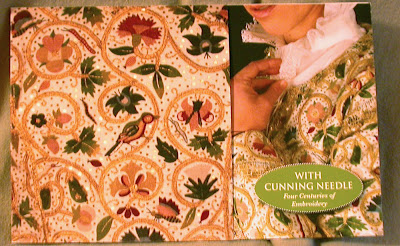For those who asked: I don't have images or scans of the stitch charts but I do have sources where I got some of them. Most of the fillings begin with a simple lattice, tacked down with a tiny diagonal stitch. I used a cut strip of paper to help guide the lattices, different sized strips for bigger or smaller lattices. Most of the lattices stitched in the sampler are vertical/horizontal, but the first and last ones are diagonal. They're done the same way: lay long parallel stitches in one direction, cross at a 90 degree angle the other way and then tie down the intersections. (stitch back and forth, not like satin stitch)
The first two samples below have a laid stitch ground. The others do not. It took way too long.
The left hand box in the first row is my attempt at using a Japanese embroidery stitch, tie-dye effect, in crewel wool. First you stitch the diagonal grid, then instead of a small diagonal tie down, you take three longer satin stitches over each intersection. Last, you add two small satin stitches to the center of each open area.
The right-hand pattern is a not very successful try at my own design. Alternating lazy-daisy stitch flowers. Kind of inspired by the Dover book mentioned below.
Second row, left is a large vertical cross in pale green over the grid lines with a yellow French knot in the other squares. This is from the Dover book, Jacobean Iron-on Transfer Patterns by Linda Ormesson. While the transfers are okay, I got the book for the three pages of filling patterns at the end.
Next to it is another lame attempt at design. I stitched large diagonal crosses and tied them down. I didn't plan it before beginning and it would be improved with better spacing, I think.
The bottom row patterns were taken from Stitches of Creative Embroidery by Jacqueline Enthoven. One is a double vertical cross, tied down with a small diagonal cross and French knots. The other is a double lattice. I stitched one lattice and tied it down and then stitched another in the same directions, midway between the laid lines of the first, and tied it down. The experiment here was with color. The bottom lattice is dark green tied down with red. The top lattice is pale green tied down with the same pale green. It gives kind of a plaid effect.
The top left strawberry is spaced buttonhole stitches on a laid ground from Crewelwork Embroidery Stitches by Anchor. The leaf on that side is satin stitch held with long laid lines that are couched at intervals. I saw this in several of the older books I've been reading and it seems to have been a common Medieval filling stitch in Europe and was also used in many other countries.
The little three-lobed leaf is shaded chain stitch.
On the right hand side, the top leaf is Battlement Couching, which is layers of grids, just moved over a bit each time, with the top layer secured at the intersections. I found that in several books. I outlined it with stem stitch. The right-hand strawberry is also from the Anchor book. Blocks of satin stitch are alternated with large crosses, tied in the centers. It was very hard to keep the satin stitch blocks even and square, even though I drew them onto the fabric.
The mounds: the top mound is rows of shaded chain stitch with the topmost row being a twisted chain so one arm sticks out (hopefully like grass). The mound on the right is a buttonhole stitch I saw in the old books. It was done as a solid filling in the books; here I spaced it out more. You stitch the first row like regular buttonhole, with the "purl" edge down. For each subsequent row you begin each stitch just above the purl edge of the previous row, stitching over the edge, as you make a new row. If it's close it doesn't look like buttonhole at all but rows of satin stitch with a raised edge.
The mound on the left began with laid stitch, then a diamond filling. I made my tie downs long--each one began right at the bottom edge of where two laid threads crossed, but then extended up midway into the diamond. I added a French knot at the end of each tie down. The idea was to look like flowers and stems.

































